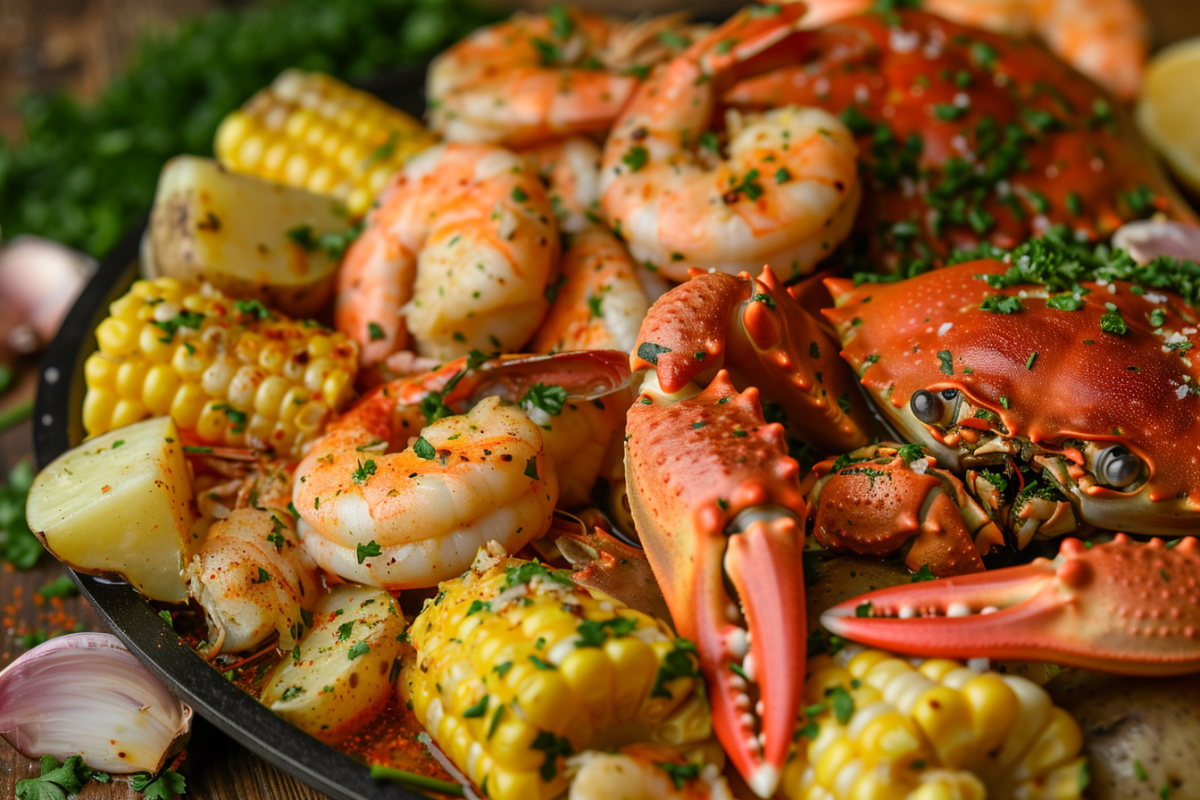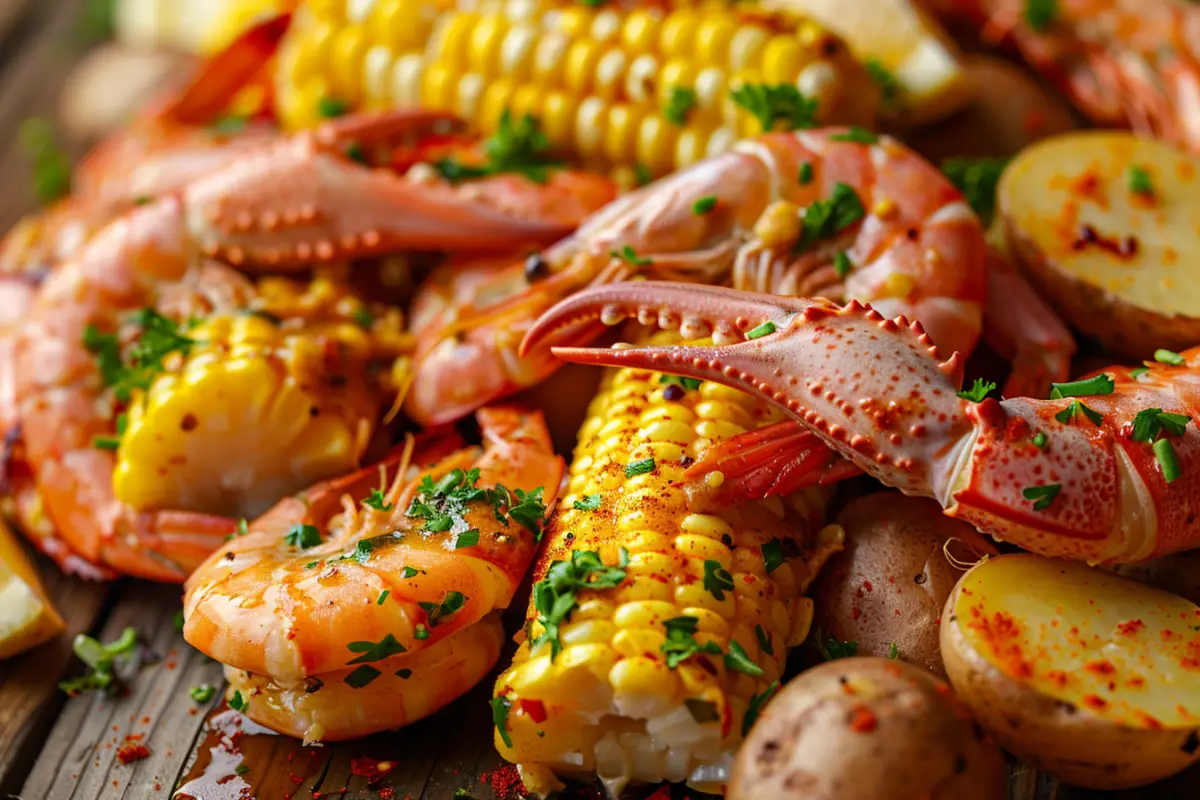Seafood boils have been a beloved tradition for generations, particularly in Southern cuisine. These gatherings revolve around giant pots filled with seafood and vegetables, but what truly elevates them is the seafood boil sauce. This rich, flavorful, buttery mixture ties everything together. So, what is seafood boil sauce made of? In this comprehensive guide, we’ll break down the components that make this delicious sauce, how you can customize it, and why it’s a crucial part of the seafood boil experience.
What is Seafood Boil Sauce?
Seafood boil sauce is a savory, buttery blend that enhances the natural flavors of seafood like shrimp, crab, and crawfish. Typically served alongside a seafood boil for dipping or tossed into the seafood mixture, this sauce provides a rich and aromatic addition to the meal. Each region offers its twist on the sauce, but the base ingredients are relatively consistent, delivering bold, spicy, and aromatic flavors.
Why Is Seafood Boil Sauce Important?
The seafood boil sauce does more than just accompany the meal—it amplifies the seafood’s flavor. It balances the sweetness of shrimp or crab with heat and spice, turning the dish into a sensory experience. Furthermore, the sauce is versatile. It serves as a dip for not only seafood but also for corn, potatoes, and even bread. Without the sauce, a seafood boil would feel incomplete.
Main Components of Seafood Boil Sauce
Understanding what seafood boil sauce is made of starts with identifying its core ingredients. These fundamental components define the sauce’s rich flavor, regardless of the specific variation used.
Butter
Butter forms the foundation of nearly every seafood boil sauce. It provides the richness and smooth texture that allows other flavors to meld together. Without butter, the sauce would lack its luxurious, creamy base.
- Types of Butter: Most recipes call for unsalted butter since it offers better control over the final flavor. However, salted butter can be a great alternative for those who prefer a saltier kick.
- Clarified Butter: Some cooks use clarified butter for a cleaner sauce. Clarified butter, which removes the milk solids, produces a smoother, more refined texture.
Garlic
Garlic is an indispensable ingredient in seafood boil sauce. Its sharp, pungent flavor adds depth and complexity, making each bite of seafood more savory.
- Fresh Garlic: For the most potent flavor, fresh garlic is the best option. Minced garlic infuses the butter with rich, aromatic notes.
- Garlic Powder: When fresh garlic isn’t available, garlic powder can serve as a suitable substitute, though it won’t offer the same intensity.
- Roasted Garlic: Roasting garlic softens its harshness and introduces a sweeter, more mellow flavor to the sauce.
Onion and Shallots
Onions or shallots bring a subtle sweetness that balances out the spice in seafood boil sauce. When sautéed in butter, they release their natural sugars, adding depth and complexity to the dish.
- Yellow Onions: These onions are most commonly used for their robust flavor that holds up well in the sauce.
- Shallots: Shallots offer a milder, more refined taste. They’re an excellent choice for those seeking a more delicate onion flavor.
Spices and Seasonings
The heart of seafood boil sauce lies in the blend of spices that give it its bold and distinctive flavor. Here are some common seasonings that transform the sauce into a flavor-packed experience:
- Old Bay Seasoning: This classic blend is a staple in seafood dishes. It combines spices like paprika, black pepper, and celery salt to create a balanced, savory flavor.
- Cayenne Pepper: Cayenne adds heat and spiciness to the sauce. You can adjust the quantity based on your heat preference.
- Paprika: Paprika lends a smoky, sweet undertone to the sauce, enriching its complexity.
- Lemon Pepper: This spice adds a citrusy zing, helping to balance the richness of the butter with a refreshing brightness.
Popular Variations of Seafood Boil Sauces
While the basic components remain the same, different regions have developed their own variations of seafood boil sauce. Each offers its own unique twist, making the dish reflective of local culinary traditions.
Cajun Seafood Boil Sauce
The Cajun seafood boil sauce is a Southern favorite, especially in Louisiana. Known for its bold flavors, this sauce includes spices that add heat, earthiness, and depth.
- Cajun Seasoning: This mix of spices typically includes paprika, garlic powder, onion powder, and cayenne pepper. Cajun seasoning gives the sauce a robust, smoky flavor that pairs well with seafood.
- Bay Leaves: Used in Cajun cooking, bay leaves provide an earthy depth that enhances the sauce’s richness.
- Hot Sauce: A few dashes of hot sauce bring a tangy heat, common in many Southern-style sauces.
Louisiana Seafood Sauce
A Louisiana seafood sauce takes the boldness of Cajun flavors even further. It typically includes hot sauce, lemon juice, and Worcestershire sauce, creating a sauce that is both tangy and spicy.
- Louisiana Hot Sauce: Known for its vinegar base and medium heat, Louisiana hot sauce is a key ingredient that brings a bright, spicy kick to the sauce.
- Lemon Juice: Freshly squeezed lemon juice adds acidity, balancing the richness of the butter and amplifying the seafood’s natural sweetness.
- Brown Sugar: For those who like a balance between sweet and spicy, a touch of brown sugar works wonders in this sauce.
Additional Ingredients for Flavor Complexity
While butter, garlic, and spices make up the essential components, other ingredients can be added to customize and elevate the flavor of seafood boil sauce.
Lemon Juice and Zest
Citrus brightens the sauce and cuts through its richness, making it a crucial element for balancing the bold flavors.
- Lemon Juice: Fresh lemon juice adds a zesty, tangy element that contrasts nicely with the butter.
- Lemon Zest: For a more intense citrus flavor, adding lemon zest provides a burst of freshness without increasing the acidity.
Chicken Stock or Broth
Some cooks like to add a small amount of broth to the sauce, which can create a more complex and luxurious flavor. It also helps to thin out the sauce slightly, making it easier to toss with the seafood.
- Chicken Broth: Adds a savory depth to the sauce, enhancing its richness.
- Seafood Stock: For an even more intense seafood flavor, some prefer to use seafood stock instead of chicken broth.
Brown Sugar and Worcestershire Sauce
A touch of sweetness and umami can bring an additional layer of complexity to the seafood boil sauce.
- Brown Sugar: Sweetness can balance the heat from the spices and adds a subtle richness to the sauce.
- Worcestershire Sauce: With its blend of tangy, salty, and umami flavors, Worcestershire sauce amplifies the savory elements in the sauce.
How to Customize Seafood Boil Sauce
One of the most exciting aspects of seafood boil sauce is its versatility. You can easily tailor the sauce to suit your taste preferences or dietary needs.

Adjusting the Heat Levels
You can customize the spiciness of your sauce based on personal preference. For those who enjoy a kick, adding more cayenne pepper or red pepper flakes will intensify the heat.
- Cayenne Pepper: Increase the amount for extra spice or reduce it for a milder flavor.
- Red Pepper Flakes: Red pepper flakes provide a more textured spice, adding heat without overwhelming the other flavors.
Making a Dairy-Free or Vegan Version
If you’re avoiding dairy, there are plenty of alternatives to butter that will still give you a delicious seafood boil sauce.
- Vegan Butter: Many vegan butters on the market offer a similar richness and consistency to regular butter.
- Olive Oil: Olive oil provides a lighter alternative to butter. While it won’t have the same richness, it works well in seafood sauces.
Adjusting the Thickness
Depending on how you plan to serve your sauce, you may want to adjust its thickness. If you prefer a thinner sauce for tossing with seafood, you can add more broth. On the other hand, if you want a dipping sauce, you may need to thicken it slightly.
- Cornstarch Slurry: A cornstarch slurry is an easy way to thicken the sauce without changing its flavor.
- Simmering: Allowing the sauce to simmer longer will naturally reduce the liquid, thickening it and intensifying the flavors.
How to Store, Reheat, and Freeze Seafood Boil Sauce
One of the best things about seafood boil sauce is that you can make it ahead of time and store it for future use.
Refrigerating
After cooking the sauce, store it in an airtight container in the refrigerator. It will keep for up to a week, making it a convenient option for meal prepping.
Freezing
You can also freeze seafood boil sauce if you want to keep it for longer. Pour the sauce into a freezer-safe container and freeze it for up to six months. When you’re ready to use it, simply thaw the sauce in the fridge overnight and reheat it on the stove.
Reheating
To reheat the sauce, warm it over low heat. Stir frequently to prevent the butter from separating. If using a microwave, heat the sauce in short intervals, stirring in between to ensure even heating.
Serving Suggestions and Uses Beyond Seafood Boil
While seafood boil sauce is traditionally used for seafood boils, it’s versatile enough to enhance a variety of other dishes. Here are some alternative ways to use this delicious sauce:
- Dipping Sauce: Serve it as a dip for vegetables, steak, or even potatoes.
- Drizzle: Drizzle the sauce over rice, pasta, or grits to add an extra burst of flavor.
- Toss It In: Use the sauce to coat lobster tails, grilled shrimp, or crab legs for an added punch of flavor.
Frequently Asked Questions (FAQs)
What is Seafood Butter Sauce Made Of?
Seafood butter sauce is typically made with butter, garlic, onions, and a mix of spices like Old Bay seasoning and cayenne pepper. Depending on the recipe, additional ingredients like lemon juice, broth, and Worcestershire sauce may be included for added flavor complexity.
What is Louisiana Seafood Sauce?
Louisiana seafood sauce is a bold and tangy sauce made from ingredients like butter, hot sauce, lemon juice, and Worcestershire sauce. It is known for its spicy, rich flavors and is often used in Southern seafood boils.
Is Orange Juice Used in Seafood Boil?
Orange juice isn’t a traditional ingredient in seafood boil sauce, but some people like to use it as a sweet, citrusy twist. It adds a unique flavor profile, offering a sweet balance to the heat from spices.
Conclusion
Now that you understand what seafood boil sauce is made of, you can start experimenting with your own version. Whether you prefer the classic butter and garlic base or a bolder Cajun or Louisiana-style sauce, this sauce is key to elevating any seafood dish. By customizing the ingredients and adjusting the flavors to your taste, you can create a sauce that perfectly complements your seafood boil. So, gather your ingredients and get cooking—the perfect seafood boil sauce awaits!

